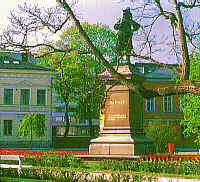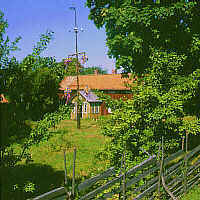|
| |
The Constitution Act of 1919, one of the oldest constitutions in the
world still in force, declares that Finland's domestic languages are Finnish and Swedish,
and that the public administration must provide for the cultural and social needs of the
country's Finnish-language and Swedish-language population on equal terms. Swedish thus
has an equal status with Finnish as an official language.
The Language Act of 1922 states that a Finnish citizen is entitled to
use either Finnish or Swedish in courts of law and in dealings with other national
authorities. The right to use one's first language with government agencies applies to the
entire country and the authorities are also required to provide people with information in
their first language.
What the law requires concerning language is based on local
circumstances. Every tenth year, the Government uses official statistics to decide how the
local State administration and local authorities should be classified linguistically.
Local authorities can be classified either as monolingual (Finnish or Swedish), or
bilingual. A municipality is classified as bilingual if a minority of at least 8% of the
population, or a minimum of 3,000 people, speak the other language. In order for a
municipality which was formerly bilingual to be considered monolingual, the number of
minority language speakers must fall to 6% of the population or less.
In a bilingual municipality, people are entitled to use either
Finnish or Swedish with local authorities, while in a monolingual one only one language
can be used. About half of all Swedish-speaking Finns live in municipalities which are
entirely Swedish-speaking or where Swedish is the majority language in a bilingual
municipality. The other half live in environments which are dominated by Finnish.
Bilingual municipalities are required to provide schools for both
language groups. The existence of a school system which can offer teaching in Swedish from
the elementary to the university level is naturally vital for the continued existence of
Swedish in Finland. Teaching at the highest level is safeguarded by one Swedish-language
university and a number of bilingual universities, as well as a number of specialist
Swedish-language tertiary-level educational institutions.
The Finnish legislation thus ensures a position for Swedish speakers
which most other linguistic minorities would consider enviable. However, the aims laid
down in the legislation cannot always be achieved in practice. Such failures are usually
caused by the difficulty of recruiting enough bilingual staff for central and local
government positions. |
|

Statue of Per Brahe,
first Chancellor of Åbo Akademi |
|
Unlike many other linguistic minorities,
Swedish-speakers in Finland have an excellent command of their language and use it in most
situations in their daily lives. In 1940, the number of Swedish-speakers in Finland was
354,000, or about 9.5% of the population. Today, the corresponding figures are 294,000
(including 25,000 people in the Åland islands) and about 6%; the decrease is partly due
to extensive emigration to Sweden during the 1960s and '70s, when the difference in the
standard of living between the two countries was still considerable. The number of people
in Finland who know at least some Swedish is much higher, however, since Swedish is a
compulsory subject at Finnish comprehensive school.
Before the introduction of comprehensive schools in the 1970s, young
people leaving elementary school had rarely received any instruction in the other domestic
language. This means that there are people among the older generation of Swedish-speaking
Finns who do not speak Finnish because they have always lived in an entirely
Swedish-language environment and never learnt Finnish at school. Most Swedish-speaking
Finns of working age are more or less bilingual, however, especially in the more urban
areas in the south of Finland. In the Swedish-speaking areas of Ostrobothnia on the coast
of the Gulf of Bothnia there are still areas where the need to know Finnish is so minimal
that much of the population cannot speak it. |
|
Åland is a special case, as the islands are a monolingual Swedish part of
Finland according to the Autonomy Act of 1920, and have the right to organize their
internal affairs themselves through their Provincial Assembly, the Åland Parliament.
Åland is a Swedish-language society, and the vast majority of Ålanders speak only
Swedish. The teaching language in all Åland schools is thus Swedish, though Finnish is
available as an optional subject in the curriculum.
|
|
 |
|